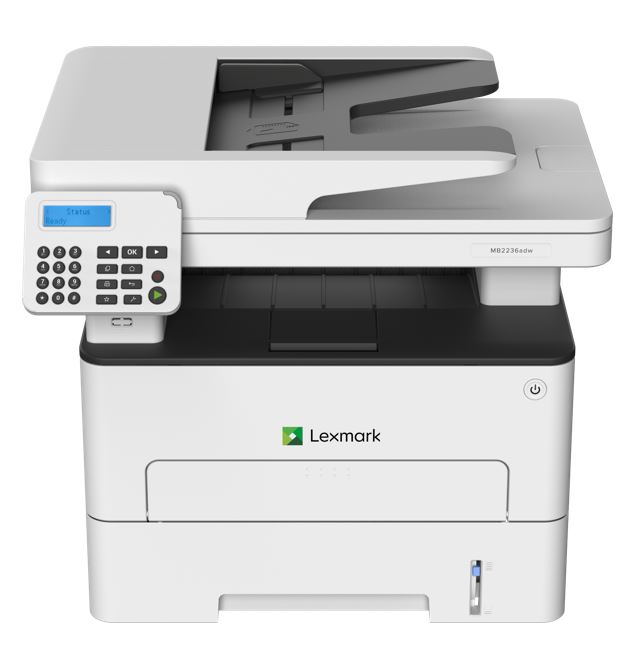Lexmark International Inc. has introduced a new line of printers aimed at helping the manufacturer expand beyond its traditional base among large businesses into the SMB segment as well.
Available now in North America and scheduled to roll out worldwide in coming months, the new Lexmark Two Series is the company’s first family of laser printers specifically tailored to the needs of micro-workgroups and small businesses, according to Sammy Kinlaw, Lexington, Ky.-based Lexmark’s vice president of channel and OEM sales.
“If you look at the laser category today, it’s roughly 34 million devices, and we’ve competed in the upper half of that stack,” he says. “We’re going to double our addressable market based on this product line.”
At present, the Two Series contains two monochrome units, the single function B2236dw and the multifunction MB2236adw. Equipped with a 1 GHz dual core processor, 256 MB of memory, and integrated Wi-Fi, the 15-lbs. B2236dw features a maximum speed of 36 pages per minute and a 30,000-page duty cycle. It’s priced at $159.99 MSRP.
“It’s robust and has a lot of performance built in,” says Terry Parker, Lexmark’s portfolio director for small workgroup mono platforms.
The MB2236adw also prints 36 pages a minute, offers a 30,000-page duty cycle, and comes with a 1 GHz dual core processor and standard Wi-Fi. Unlike its single-function sibling, however, the multifunction unit weighs 22 lbs., provides 25 page-per-minute mono simplex scanning, and features both 512 MB of memory and a simplex automatic document feeder. It lists at $229.99.
Both devices support setup, configuration, and printing on the go via Lexmark’s mobile app. Toner cartridges are available in 1,200-page, 3,000-page, and 6,000-page sizes priced at $44.99, $79.99, and $159.99 respectively. The largest of those options, according to Parker, helps small businesses and MSPs minimize truck rolls to branch offices without in-house IT staff.
Additional Two Series devices will reach market later this year. According to Kinlaw, all of them will be engineered to the requirements of smaller businesses. “The products are small, compact, lightweight, secure, and fast,” Kinlaw says, adding that they’re priced to fit SMB budgets as well.
Kinlaw, an IBM and Lenovo veteran who stepped into his current post roughly a year ago, is in the midst of an ongoing campaign to increase Lexmark’s single-digit printer market share by adding new SMB partners and doing more business with existing ones. That initiative includes the debut last fall of the company’s SMB-targeted GO Line of printers and the launch of new cloud-based fleet and print management solutions.
According to Kinlaw, those efforts have collectively generated 7- to 10-percent growth across core market segments to date. “I’m really, really thrilled with the results that occurred last year in North America,” he says. “The market is not growing, so for me to grow positive year over year I had to grow at a premium to the market.”
That Lexmark all but completely refreshed its printer catalog last year, turning over 92 percent of its portfolio, contributed to those results, Kinlaw adds. “That only happens every five years or so in the print space,” he says. “We had a lot of good things to talk about and a lot of reasons for our partners to consider us.”
Though there will be fewer new offerings to tout this year, Kinlaw predicts sustained momentum among SMBs just the same. “As people experience the new products, I’m expecting new partners to sell even more,” he says, adding that the launch of Two Series products like those unveiled today will further help by pulling net new accounts from the lower end of the SMB spectrum into Lexmark’s customer base.
“This is a gamechanger,” says Kinlaw of the Two Series. “This is going to allow me to sell hundreds of thousands of new products that I did not have an opportunity to sell before.”
He’ll need those sales to meet Lexmark’s steep channel revenue goals for 2019. “The company is asking my community to grow in high double digits,” Kinlaw says. “To grow in that manner when the market is forecasted to be flat at best means you’ve got to take share, and to be able to take share you have to be aggressive, and you have to have very defined strategies, and you have to have very firm recruitment, and you have to have a coverage model that allows you to go deeper within established partners.”
All of those elements are in place, Kinlaw continues. The enhanced coverage model includes a new partner onboarding team and an expanded force of account reps specifically tasked with serving smaller VARs. “For the Americas, I’m covering 2,500 partners that had no coverage in the prior years,” Kinlaw says.
Lexmark is offering partners fatter rebates, discounts, and spiffs as well. “We’ve significantly improved the margin enhancement offers,” Kinlaw notes. “It’s a broad revamp to make sure our money is where our mouth is.”
Looking ahead to the coming year, Kinlaw plans to make streamlining operational processes a priority. “I just have to make sure that the selling path is efficient and fast and profitable for channel partners,” he says. “I’ve got to be vigilant in making sure that if a process is lengthy, I shorten it, and that if a process is unnecessary, I get rid of it.”
Like the rest of Lexmark’s SMB push, that effort won’t lack for backing from above. “We have executive level support from all of the C levels in our company,” Kinlaw says.













